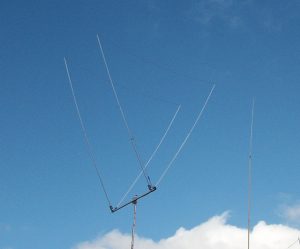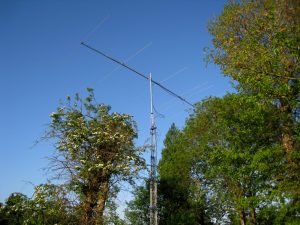LB Cebik [W4RNL] – Antenna Modelling
1. Converging Toward Excellence
2. Under the Limits – MININEC
3. Within the Lines – NEC-2
4. A Good Start is Half the Trip
5. Putting Sources Where You Can Find Them
6. Modelling Loads – What Kind, How Much and Where
7. Maximizing Your Data
8. Modelling Wire Arrays
9. Modelling Ground Planes and Other Radial Systems
10. Tapering to Perfection
11. A Ground Is Just a Ground – Unless It Is a Model of a Ground
12. Verticals At and Over Ground – Sensible Expectations
13. Notes on Reactive Antenna Loads and Their NEC Models – Centre Loading
14. Notes on Reactive Antenna Loads and Their NEC Models – Mid Loading
15. Notes on Reactive Antenna Loads and Their NEC Models – Linear Loading
16. Notes on Reactive Antenna Loads and Their NEC Models – Solenoid Loading
17. Notes on Reactive Antenna Loads and Their NEC Models – Unfinished Business
18. Why Tri-Banders Are Hard to Model
19. What Can We Learn From Tables
20. The Average Gain Test
21. The NEC TL Facility
22. Modelling Physical Transmission Lines
23. Modelling LPDAs
24. The Power and the Source
25. Bringing Up the Rear – Front-to-Back Ratios
26. The Scales of Equivalence
27. Modelling By Equation. ‘A’ – A Beginning
28. Modelling By Equation. ‘B’ – Bigger and Better Things
29. Modelling By Equation. ‘C’ – Formulas and Blocks
30. Modelling By Equation. ‘D’ – Scratch Pads and Coordinates
31. A Case Study – A 90′ Wire
32. A Case Study – Rotating a Beam
33. A Clean Sweep
34. The Second Ground Medium
35. Notes on Using AZ-EL Plots Effectively
36. Getting a Grip on AZ-EL and Phi-Theta
37. Verticals Using the MININEC Ground
38. Radials – Segmentation and Convergence
39. Radials – Complex Radial Systems
40. Resolution
41. Multiple Feed Point Loop Modelling
42. Moving and Rotating
43. Modelling Element Substitutes
44. Designing With NEC. A Case Study – Part 1 – The 4 S’s
45. Designing With NEC. A Case Study – Part 2 – Evaluation and Reality
46. A Load in Parallel With a Source
47. So You Want to Read an NEC-Deck
48. Radiation Plots – Polar or Rectangular. Log or Linear
49. Traps
50. The NEC-4 IS Card – Insulated Wires
51. Testing the Fringes of Modelling Programs
52. Flipping Among NEC Programs
53. Voltage and Current Sources. How?
54. GC – Wire Segment Length and Radius Tapering
55. Parallel Sources, Angular Junctions, and Average Gain – Correcting ‘Weaknesses’
56. When MININEC is Superior to NEC
57. Some Comments on Comments
58. Some Basic Guideline Graphics for NEC
59. MININEC and NEC – A Design Case Study
60. NVIS Antenna Models and the Ground Type
61. GM – Coordinate Transformation
62. GH – Helix-Spiral Specification
63. GH and GM – The NEC-4 Versions
64. An Orientation to the NEC Output File
65. The Half-Wavelength Resonant Dipole as a Core Test Instrument
66. State of the Art
67. Wire Grids 1 – Plane and Simple
68. Wire Grids 2 – Angular and Awkward
69. 4-8-16-Infinite Sided Loops
70. Refining Physical Transmission-Line Models
71. The Average Gain Test Revisited
72. The GX or Symmetry Geometry Input
73. Source-to-Feedline Matching Techniques
74. Some Numerical Green’s Function Rudiments
75. NEC – Power Efficiency vs Radiation Efficiency
76. Developing Antenna Expectations Using Modelling Software – Part 1 Horizontal Wires Lower Medium HF Range
77. Developing Antenna Expectations Using Modelling Software – Part 1 cont. – Horizontal Wires Lower Medium HF Range
78. Developing Antenna Expectations Using Modelling Software – Part 2A – Vertical Dipoles
79. Developing Antenna Expectations Using Modelling Software
80. Developing Antenna Expectations Using Modelling Software – Part 2B – Vertical Monopoles
81. Appreciating EK
82. The Nature and Adequacy of NEC Correctives
83. Insulated Wires – The NEC-2 Way
84. GA – Creating and Moving Arcs
85. Electrical Fields at a Power Level and Distance
86. NEC-2 Manual Sample Files
87. NEC-4 Manual Sample Files
88. EX and PT
89. A Note on Archimedes and Log Spirals for the NEC-4 GH Command
90. An Orientation to NEC Near Fields. Part 1. NEC-2 Input Basics and Simple Outputs
91. An Orientation to NEC Near Fields. Part 2. Some Refinements and NEC-4 Additions
92. Calculating Circular Gain
93. Convergence Revisited
94. GR – The ‘Generate Cylindrical Structure’ Command
95. Some Basics of the NT Command
96. Some Further Applications of the NT Command
97. Integrating Commands – A Case Study
98. Planar Reflectors – Wire Grid vs. SM Patches
99. S-N, RCA, and MININEC Grounds
100. The Dipole and the Coax
101. Modelling the ‘Un-Modellable’
102. True Azimuth Models – NSI Software
103. True Azimuth Models – EZNEC Software
104. PS – I Change
105. Models, Symmetry, and Loads – A Couple of Reminders
106. Refining Our Notions of Azimuth Patterns
107. Scaling Models
108. Dipoles – Variety and Modelling Hazards Linear, V and Folded Dipoles in NEC
109. Dipoles – Variety and Modelling Hazards Linear, V and Folded Dipoles in MININEC
110. Dipoles – Variety and Modelling Hazards Tapered-Diameter, Bent and Hatted Dipoles
111. Dipoles – Variety and Modelling Hazards Zig-Zag, Fold-Back and Fan Dipoles
112. Wires Meeting Ground – 2 Cases
113. When Simple Geometries Become Complex. A Rhombic Case Study.
114. Modelling Folded Monopoles
115. Single, Bifilar and Quadrifilar Helices
116. Insulation Revisited
117. Modelling and the Logic of Question Resolution
118. Modelling Odd Structures The Gamma Match. Part 1 Gamma Modelling Basics
119. Modelling Odd Structures The Gamma Match. Part 2. Gamma Assembly Variables
120. Back on the Ground
121. Radiation Patterns and Propagation
122. Reciprocity – Home on the Range
123. Radiating and Transmission-Line Currents
124. Modelling (with) Parabolic Reflectors
125. When to ‘Worry’ and When Not to Worry – A Case Study
126. ‘Ideal’ Polar Plots
127. A Potpourri of Modeller Miscellanea
128. When Not to Use NEC for Antenna Modelling
129. Some Rudiments of Receiving Pattern Modelling
130. Models vs. Prototypes – Why Field Adjustment Will Always be Necessary
131. AM Broadcast Modelling with NEC. Part 1 – Basic Considerations
132. AM Broadcast Modelling with NEC. Part 2 – Quandaries – How Many Legs and How Good is Good
133. AM Broadcast Modelling with NEC. Part 3 – The Long and Short of It
134. AM Broadcast Modelling with NEC. Part 4 – Square, Sloping, and Tapered
135. AM Broadcast Modelling with NEC. Part 5 – Multiple Tower Arrays
136. AM Broadcast Modelling with NEC. Part 6 – Grounds
137. NEC Implementations – Cores, Limitations and Work-Arounds
138. Types of Substitute Models
139. Antenna Matching with EZNEC Version 5 – Part 1. Transformers and Shunt loads
140. Antenna Matching with EZNEC Version 5 – Part 2. L-Networks
141. Circular R-X Graphs
142. VOACAP Type 13 Files
143. Modelling Radiating Surfaces
LB Cebik [W4RNL] – QST Articles
A Beginner’s Guide to Modelling with NEC Part 1 – Getting Started
A Beginner’s Guide to Modelling with NEC Part 2 – The ‘Ins’ and ‘Outs’ of Modelling
A Beginner’s Guide to Modelling with NEC Part 3 – Sources, Grounds and Sweeps
A Beginner’s Guide to Modelling with NEC Part 4 – Loads, Transmission Lines and Limitations
LB Cebik [W4RNL] – Antenna Modelling Notes Volumes 1-7
W4RNL Antenna Modelling Notes Volume 1
W4RNL Antenna Modelling Notes Volume 2
W4RNL Antenna Modelling Notes Volume 3
W4RNL Antenna Modelling Notes Volume 4
W4RNL Antenna Modelling Notes Volume 5
W4RNL Antenna Modelling Notes Volume 6
W4RNL Antenna Modelling Notes Volume 7


